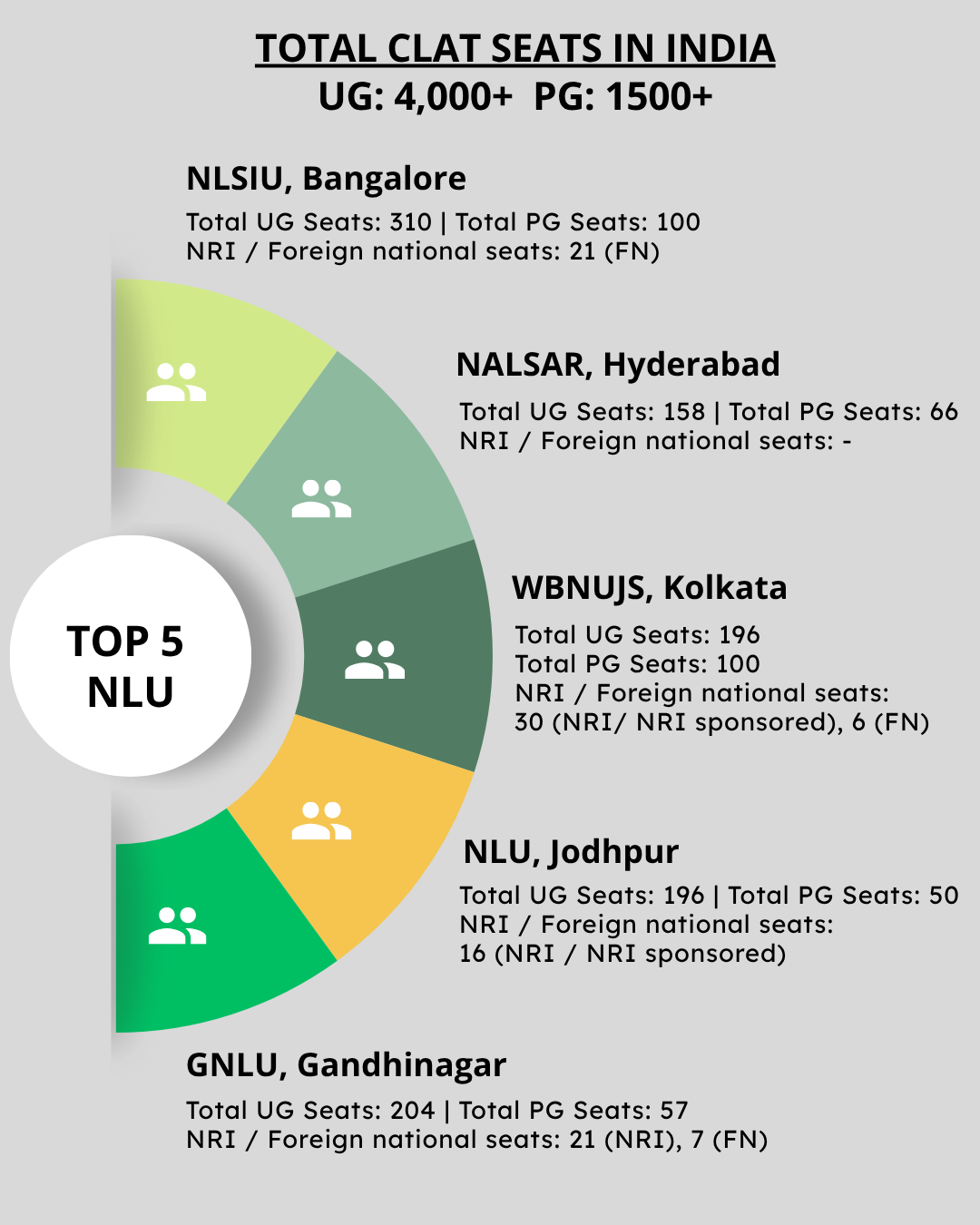Total Seats in CLAT 2026: How Many CLAT Seats Are There in India?
In India, roughly 200,000-300,000 law aspirants compete fiercely for about 4,500+ total CLAT seats in India. That’s a competitive ratio of almost 30:1. This isn’t just about hard numbers. Understanding the total number of CLAT seats in India, where they are, which NLUs have them, and what reservation policies apply is absolutely critical to your law school selection strategy.
In this comprehensive guide, we’re breaking down everything you need to know about total CLAT seats in India for both undergraduate (UG) and postgraduate (PG) programs. You’ll discover:
Exact seat distribution across all participating NLUs, Category-wise reservation breakdown, Domicile quota allocations, How seats have evolved year-over-year, Which NLUs offer the most seats (and why this matters), and FAQs that answer real questions law aspirants have.
Let’s begin.
Total Seats in CLAT: 2026 CLAT Seats Intake
For CLAT 2026, the total seat count is:
- Undergraduate (LLB): 4,300+ seats (including NRI/Foreign National and supernumerary seats)
- Postgraduate (LLM): 1,550+ seats (including NRI/Foreign National and supernumerary seats)
Total CLAT Seats 2026: 5,500+ seats across all National Law Universities
| Law Colleges | Total UG Seats | Total PG Seats | NRI / Foreign national seats |
| NLSIU, Bangalore | 310 | 100 | 21 (FN) |
| NALSAR, Hyderabad | 158 | 66 | |
| WBNUJS, Kolkata | 196 | 100 | 30 (NRI/ NRI sponsored), 6 (FN) |
| NLU, Jodhpur | 196 | 50 | 16 (NRI / NRI sponsored) |
| GNLU, Gandhinagar | 204 | 57 | 21 (NRI), 7 (FN) |
| NLIU, Bhopal | 68 | 60 | 27 (NRI/ NRI sponsored), 5 (FN) |
| MNLU, Mumbai | 122 | 50 | 40 (NRI/NRI sponsored/ FN) |
| RMLNLU, Lucknow | 191 | 31 | 25 (NRI/NRI Sponsored/ FN) |
| HNLU, Raipur | 170 | 90 | 8 (NRI), 2 (FN) |
| NUALS, Kochi | 78 | 60 | 6 (NRI sponsored), 2 (FN) |
| NLUO, Odisha | 180 | 46 | 19 (NRI/NRIS/PIO/OCI), 8 (FN) |
| GNLU, Silvassa Campus | 66 | 33 | |
| RGNUL, Patiala | 214 | 60 | 5 (NRI), 2 (FN) |
| NUSRL, Ranchi | 201 | 50 | |
| DSNLU, Visakhapatanam | 132 | 60 | 18 (NRI / NRI Sponsored/ FN) |
| CNLU, Patna | 138 | – | 5 (NRI) |
| TNNLU, Tiruchirappalli | 120 | 18 | 6 (NRI/OCI guardian) |
| MNLU, Nagpur | 240 | 60 | |
| MNLU, Aurangabad | 120 | 60 | |
| NLUJA, Assam | 69 | 40 | |
| HPNLU, Shimla | 220 | 80 | 39 (NRI/ FN) |
| DNLU, Jabalpur | 134 | 50 | |
| DBRANLU, Haryana | 120 | – | |
| NLUT, Agartala | 60 | 50 | |
| RPNLUP, Prayagraj | 63 | – | |
| Delhi University | 120 | – | |
| ILNU, Ahmedabad | 300 | – | |
| Shiv Nadar School of Law | 120 | – |
Also read, Top Law Colleges in India | All About NLUs in India
How Many Seats are There in CLAT?
The quick headline numbers of total CLAT seats in India (verified) are as follows;
- Approximate total UG seats (NLUs, CLAT): ~4,092
This number generally excludes supernumerary and NRI/Foreign-national extra seats.
- Approximate total PG seats (LLM across NLUs): ~1,599
These numbers represent a historic expansion. Just 5 years ago (2020-21), CLAT offered approximately 2,800 seats. The addition of RPNLU Prayagraj and IIULER Goa in recent years has pushed the number beyond 5,600 over a decade.
CLAT Seats in Non-NLUs
Total seats in Non-NLU colleges through CLAT exam are more than 10,000 seats across 75+ law colleges. Examples of Non-NLU CLAT accepting colleges are:
- Government Law College (GLC) Mumbai: 240 seats
- SVKM Pravin Gandhi College of Law Mumbai: 120 seats
- BITS Law School Mumbai: 180 seats
- Symbiosis Law Schools (Pune, Hyderabad, etc.): ~500+ seats
- Christ University Law School: 180 seats
Total CLAT Seats Including Non-NLU Colleges: ~10,000-12,000 seats
While seat numbers have grown, so have applicants. The CLAT exam consistently sees 150,000-300,000 applications annually, making it increasingly competitive despite the seat increase.
Also read, Top Colleges to Study Law Through CLAT
State Quota CLAT Seats in NLUs: State Domicile Reservation for LLB
The NLUs reserve some seats under a state quota for CLAT seats. Each NLUs keep such seats under State Domicile reservation category for candidates from the very state where that NLU is located. The NLU-wise State Domicile reservation is given here:
| Law College | State Domicile % |
| NLSIU Bengaluru | 25% |
| NALSAR Hyderabad | 25% |
| WBNUJS Kolkata | 33% |
| NLIU Bhopal | 50% |
| NLU Jodhpur | 25% |
| HNLU Raipur | 50% |
| GNLU Gandhinagar | 25% |
| GNLU Silvassa Campus | 25% |
| RMLNLU Lucknow | 45% |
| RGNUL Patiala | 10% |
| CNLU Patna | 50% |
| NUALS Kochi | 49% |
| NLUO Cuttack | 25% |
| NUSRL Ranchi | 50% |
| NLUJA Guwahati | 50% |
| DSNLU Visakhapatnam | 48% |
| TNNLU Tiruchirappalli | 48% |
| MNLU Mumbai | 62% |
| MNLU Nagpur | 62% |
| MNLU Aurangabad | 62% |
| HPNLU Shimla | 25% |
| DNLU Jabalpur | 50% |
| DBRANLU Sonipat | 25% |
| NLUT Agartala | 30% |
CLAT Seats Reservation Policy: How Total CLAT Seats Are Allocated
This is where many aspirants get confused. “Total seats” doesn’t mean everyone competes for all seats.
| Category | Percentage | Example (100 seats) |
| General (Unreserved) | 50-60% | 50-60 seats |
| SC | 15-16% | 15-16 seats |
| ST | 7-8% | 7-8 seats |
| OBC NCL | 27% | 27 seats |
| EWS | ~10% | 10 seats |
| Total | 100% | 100 seats |
Note: There is a horizontal reservation for women (~33%) across many NLUs.
How to Calculate Your Actual Competition for Total Seats in CLAT: Example
Let’s work through an example:
If you’re a General category candidate from Karnataka, applying to NLSIU Bangalore (310 total UG seats with 25% Karnataka domicile).
- Total UG seats: 310
- Apply state domicile: 310 × 25% = 78 Karnataka seats, 232 All India seats
- General/Unreserved: Approximately 50-55% of All India seats
- Your actual competition pool: 232 × 0.50 => 116 seats
You’re competing Against: 150,000+ national General category candidates for those 116 seats. You will require, typically, 95+ percentile in CLAT exam to secure a NLSIU Bangalore seat.
Also read, CLAT Cutoffs and Exam Analysis
Difference Between “Available CLAT Seats” vs. “Total Seats in CLAT”
When the total no. of seats in CLAT are 5,500+, this is not the number of seats available to any single candidate. It’s the aggregate across all categories and quotas.
Example Breakdown (MNLU Mumbai 100 UG Seats):
| Category | Seats | Reservation | Percentage |
|---|---|---|---|
| Maharashtra General | 31 | Maharashtra Domicile | 62% |
| Maharashtra SC | 10 | Maharashtra Domicile + SC | |
| Maharashtra ST | 5 | Maharashtra Domicile + ST | |
| Maharashtra OBC/EWS | 16 | Maharashtra Domicile + OBS/EWS | |
| All India General | 19 | No Domicile | |
| All India SC | 6 | No Domicile | 15% |
| All India ST | 3 | No Domicile | 7.5% |
| All India OBC/EWS | 10 | No Domicile | 27% |
| NRI/Foreign National | ~5 | Supernumerary | |
| Total | 100 |
How to Secure a Seat in Law College: CLAT Preparation, Cutoff Targeting & Must-Use Resources
Understanding the total CLAT seats in India is only half the story. The real challenge is earning one of those seats and that boils down to how strategically you prepare for CLAT, especially with the exam scheduled in December. With nearly 4,500+ UG seats across NLUs and lakhs of aspirants competing for them, you need a preparation plan that is both smart and cut-off-focused.
1. Start by Targeting NLU-Wise Cutoffs
Every NLU has its own cutoff scores for CLAT. For example, top NLUs like NLSIU Bengaluru and NALSAR Hyderabad demand single or low double-digit ranks. When you know the total seats and CLAT cutoff pattern, you can reverse-engineer your goal.
If you are aiming for a top NLU, you need to target high accuracy in Legal Reasoning + English, and a raw score that consistently crosses the top-5 NLU cutoff bandwidth.
Read more: CLAT Cutoffs
2. Attempt CLAT Mock Tests
If you want a seat in NLUs, mock tests aren’t optional. Timed and adaptive mock tests build exam temperament. The cutoff prediction becomes more accurate when you benchmark your mock scores against national averages.
Take CLAT mock tests for:
- Realistic CLAT-level difficulty
- Sectional timing
- Rank predictor + percentile
- Video solutions from experts
- Topic-wise performance breakdown
Detailed mock analysis helps you reduce negative marking and improve attempt strategy.
Conclusion: Total No. of Seats in CLAT
Knowing the total number of CLAT seats in India helps you estimate rank cutoffs for various NLUs and plan application preferences. It also helps candidates decide whether they should apply to NLUs, private law colleges, or backup options.
FAQs About CLAT Seats in India
What’s the total number of CLAT seats in India 2026?
5,600+ total CLAT seats are available across 26 National Law Universities. 4,092 CLAT seats are available for UG and 1,599 PG for LLM. This includes NRI/Foreign National/Supernumerary seats.
How many NLUs participate in CLAT exam?
26 NLUs participate in CLAT exam 2026, including newly added institutions like RPNLU Prayagraj and IIULER Goa. Additionally, 60+ non-NLU law colleges accept CLAT scores, bringing total CLAT-accepting institutions to 80+.
Can the total number of CLAT seats increase in future?
It’s possible, especially with campus expansions, but regulatory limits and quality constraints can limit the growth in the total number of CLAT seats.
Which NLU has the most seats?
NLSIU Bangalore has the highest total seat capacity. UG Seats are 310 (increased from 240 in 2024) and PG seats are 100. Additionally NRI seats are 21. This makes NLSIU Bangalore the NLU with maximum opportunities but also highest competition due to prestige.
Are LLM seats easier to get than UG seats?
Generally yes, due to lower competition. While LLM (1,599 seats) represents 26% of total CLAT seats, they attract only 5-8% of CLAT applicants—most focus on UG seats.
Working professionals or candidates unable to secure UG seats often get into top NLU LLMs with lower cutoffs which is typically 75-85th percentile vs. 95th+ percentile for UG.
How many seats are reserved for SC/ST/OBC/EWS?
Typical reservation breakdown across NLUs is as follows:
SC: 15-16%
ST: 7-8%
OBC: 27%
EWS: ~10%
Total reserved seats: ~50-60% of seats, General/Unreserved: ~40-50%.







